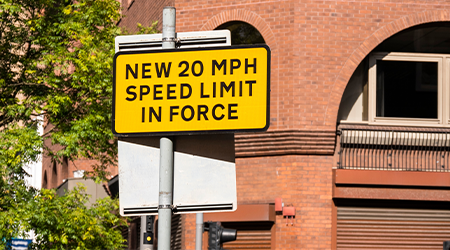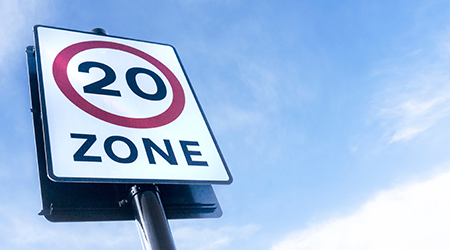
In a bold move towards safer and more sustainable roadways, the United Kingdom has been gradually implementing 20mph speed limits in various regions, including the picturesque landscapes of Wales. As of 17th of September 2023, Wales will become the first country in the world to adopt the 20mph speed limit by default.
The rationale behind this decision is to proactively address safety concerns, aiming to curb accidents, minimise noise pollution, and promote alternative modes of transportation such as walking and cycling. This shift towards lower speed limits is driven by a desire to create a more pedestrian-friendly environment and enhance overall road safety in congested areas.
In this blog, we’ll delve into the nuances of this change specifically to the Wales speed limits, from its effectiveness to its enforcement, and explore the differences between a 20mph speed limit and a 20mph zone.
Wales 20mph Speed Limit: What You Need to Know
Wales, known for its stunning landscapes and historic charm, has embraced the 20mph speed limit as a crucial step towards enhancing road safety and reducing accidents.
These speed limits are typically introduced in residential areas, around schools, and in busy city centres. The move is a part of the broader effort to create more pedestrian-friendly spaces and promote active transportation.
In addition to the change in Wales, Scotland has also declared it will follow suit in 2025.
Speaking to the BBC, Welsh First Minister Mark Drakeford said, “We know that 20mph zones reduce speed of traffic, reduce accidents – particularly accidents to children. We want to see that become the default position right across Wales.
The decision of the Welsh government has received support from both the Labour and Plaid Cymru parties.
“We’re united in our belief that this change will bring about a reduction in road collisions and their severity, while creating more opportunities to walk and cycle in communities,” said Plaid Cymru’s transport spokeswoman, Delyth Jewell.
“A 20mph speed limit in built-up areas will allow us to work toward providing convenient, safe, pedestrian access to the places people need to go.”
What is the Difference Between a 20mph Zone and a 20mph Speed Limit?
While the terms might seem interchangeable, there is a significant difference between a 20mph zone and a 20mph speed limit.
A 20mph zone involves a comprehensive package of traffic-calming measures, such as speed humps, chicanes, and narrower lanes, aimed at naturally encouraging drivers to adhere to the lower speed limit.
On the other hand, a 20mph speed limit involves changing the maximum speed limit signs without implementing physical traffic-calming measures. The effectiveness of both approaches depends on factors like driver compliance and road design.
Do 20mph Speed Limits Work?
Research and real-world data have shown that 20mph speed limits can indeed have a positive impact on road safety.
Lowering the speed limit reduces the severity of accidents and gives drivers more time to react, especially in areas with heavy foot traffic. According to a public health study, decreasing the default speed limit to 20mph will result in 40% fewer collisions, which will save 6 to 10 lives every year.
Additionally, it contributes to a quieter and more pleasant urban environment, encouraging people to walk and cycle more frequently.

Are 20mph Speed Limits Enforceable?
One common concern surrounding these lower speed limits is enforceability. However, advancements in technology, such as speed cameras and automatic number plate recognition systems, have made enforcing 20mph speed limits more feasible.
The combination of education, awareness campaigns, and enforcement measures can encourage drivers to respect the new speed limits.
Anyone who is caught speeding in these areas will face a £100 fine and 3 points added to their licence.
Why are Red Ribbons on Cars in Wales?
Motorists in Wales have taken to a unique form of protest, adorning their vehicles with red ribbons to express their disagreement with the newly imposed 20mph speed limits. The Welsh government’s recent decision to reduce the speed limit from 30mph to 20mph in built-up areas has sparked controversy and debate among drivers.
The red ribbons symbolise a nod to the historical origins of motoring, evoking memories of a time when a person carrying a red flag was mandated to lead sluggish automobiles. The Locomotive Act of 1865, more famously referred to as the Red Flag Act, stands as a testament to this era. According to this law, any self-propelled road vehicle was obligated to have an individual walk a substantial distance of 60 yards in advance, holding a red flag. This regulation harkens back to a period of cautious progression in the world of automobiles.

How Could This Affect Me?
As a motorist, pedestrian, or cyclist, the implementation of 20mph speed limit signs in Wales can significantly affect your experience on the road.
You might notice smoother traffic flow, reduced noise levels, and an increased sense of safety as you navigate through urban and residential areas.
For drivers, adjusting to these new speed limits requires heightened awareness and a willingness to adapt to changing road conditions.
In conclusion, the introduction of 20mph speed limits in Wales reflects a broader shift towards prioritising safety, sustainability, and community well-being. As motorists and citizens, we all play a vital role in ensuring the success of these changes. By embracing the lower speed limits and respecting the rules of the road, we can contribute to creating a safer and more enjoyable environment for everyone.
So, next time you’re cruising through the charming streets of Wales, remember that by adhering to the 20mph speed limit, you’re not only abiding by the law but also contributing to the greater good of your community.